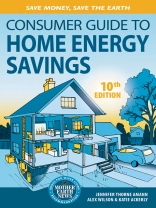The most complete and up-to-date guide available to energy savings in the home .
Increasing the energy efficiency of your home can save you money, help the environment, and enhance your comfort, but how do you decide which improvements are the most beneficial and cost-effective? Completely revised to incorporate the latest developments in green technology, The Consumer Guide to Home Energy Savings is the definitive resource for consumers who want to better their home’s performance while reducing their energy bills.
Well-organized and highly readable, The Consumer Guide to Home Energy Savings begins with an overview of the relationships between energy use, economics and the environment. Updated and expanded chapters focus on specific aspects of any home, such as heating and cooling, ventilation, electronics, lighting, cooking and laundry, and provide helpful explanations for each, including:
- Energy use characteristics
- Comparisons between available technologies
- Cost-effective repair and replacement options
- Step-by-step guidance for finding the right equipment.
This comprehensive resource is packed with tips on improving existing equipment and guidance for when and why to invest in new purchases, as well as a reminder to check local government and utilities for purchase or retrofit grants or incentives. It is a must-read for anyone concerned about reducing both their energy bills and their environmental impact.
قائمة المحتويات
Home Energy Checklist for Action
Lists of Tables
Acknowledgments
Chapter 1 Save Money, Save the Earth
Chapter 2 The Building Envelope
Chapter 3 Ventilation and Air Distribution
Chapter 4 Heating Systems
Chapter 5 Cooling Systems
Chapter 6 Water Heating
Chapter 7 Food Storage
Chapter 8 Cooking
Chapter 9 Dishwashing
Chapter 10 Laundry
Chapter 11 Lighting
Chapter 12 Home Electronics
Chapter 13 Other Energy Uses in the Home
Appendix For More Information
Index
About the Authors
About ACEEE
عن المؤلف
Katie Ackerly conducts research at the Center for the Built Environment at UC Berkeley, while completing advanced degrees in building science and architectural design. Previously at the American Council for an Energy-Efficient Economy, she has written several papers related to the interface of green technologies and human behavior.












